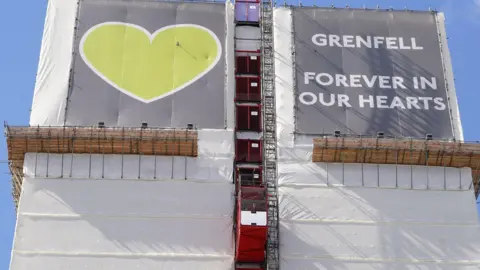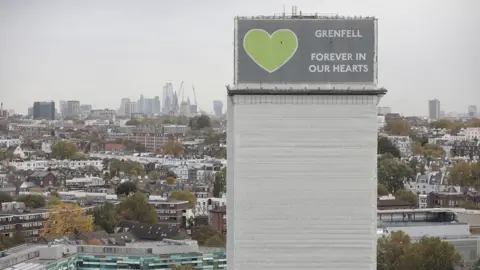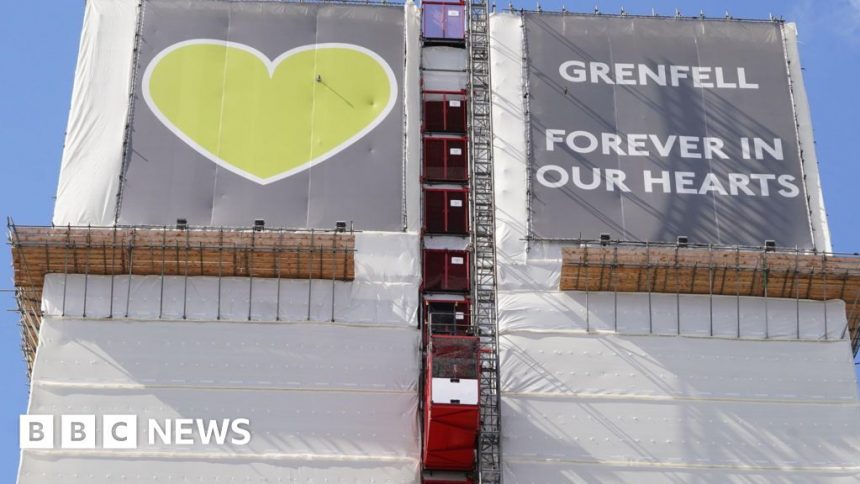Grenfell’s path to disaster: How chain of failures and dishonesty led to 72 deaths
 PA
PAThe Grenfell Tower fire that killed 72 people in 2017 was the result of a chain of failures by governments, “dishonest” companies and a lack of strategy by the fire service, the final report of the six-year public inquiry has concluded.
The damning report sets out a “path to disaster” at Grenfell stretching back to the early 1990s over how fire safety in high rise buildings has been managed and regulated.
The coalition and Conservative governments “ignored, delayed or disregarded” concerns about the safety of industry practices, the inquiry added.
The manufacturer of cladding products “deliberately concealed” the fire risks they posed, the report added.
Among the recommendations laid out in the 1,700-page report are the introduction of a single construction regulator, a College of Fire and Rescue to improve the training of firefighters and changes to the way materials are tested for fire safety.
The report’s publication comes more than seven years after the fire took hold and spread through cladding on the West London tower block.
The fire started in a fridge on the fourth floor and spread to the cladding through a window, before racing up the sides of the building. Many residents were trapped on higher floors as it spread.
The cladding was made of highly flammable polyethylene which was added to the sides of Grenfell Tower in a disastrous refurbishment in 2016.
The inquiry found fault and incompetence among almost every company involved in the refurbishment.
Among the key findings of the report were:
- “Systematic dishonesty” by the manufacturers of cladding and insulation
- US firm Arconic, manufacturer of the Reynobond 55 cladding which experts at the inquiry said was “by far the largest contributor” to the fire, deliberately concealed the true extent of the danger of using its product
- Manufacturers made “false and misleading claims” over the safety and suitability of insulation to the company which installed it on Grenfell
- Failures in London Fire Brigade’s training and a lack of a strategy to evacuate the building
- Successive governments missed opportunities to act
- The local council and the Tenant Management Organisation had a “persistent indifference to fire safety, particularly the safety of vulnerable people”
- How building safety is managed in England and Wales is “seriously defective”
 Getty Images
Getty Images“Unscrupulous” manufacturers
The inquiry examined the roles of three companies which made cladding and insulation used in the refurbishment of Grenfell Tower.
In a key passage it concluded:
“One very significant reason why Grenfell Tower came to be clad in combustible materials was systematic dishonesty on the part of those who made and sold the rainscreen cladding… and insulation.”
They engaged in “deliberate and sustained strategies to manipulate the testing processes, misrepresent data and mislead the market,” the report found.
Arconic produced panels of Reynobond PE cladding, formed from metal sheets with a plastic layer. This was “extremely dangerous” when folded into box shapes, a practice widely used in the cladding industry, the inquiry concluded.
The cladding was “by far the largest contributor” to the Grenfell fire, according to new research by two inquiry experts.
However from 2005 until after the Grenfell Tower fire, Arconic “deliberately concealed from the market the true extent of the danger of using Reynobond 55 PE in cassette form, particularly on high rise buildings.” It allowed customers to continue buying the product.
It allowed customers to continue buying it despite fires in Dubai in 2012 and 2013.
Arconic commissioned fire tests which revealed very poor ratings for cladding installed as folded cassettes but concealed these from the BBA, a British private certification company which attempted to keep the construction industry up to date about safety risks.
This “caused BBA to make statements that Arconic knew were ‘false and misleading’”, the report said.
Among the UK customers which were misled, was Harley Facades, the company which installed the Grenfell cladding.
The inquiry also found fault with both Celotex and Kingspan, which both made insulation, also part of a cladding system.
Celotex made “false and misleading claims” and presented its product to Harley Facades as being safe and suitable for Grenfell although ”it knew that was not the case.”
It use magnesium oxide boards, which do not burn, during testing and did not reveal this in marketing literature.
Kingspan, which had led the way in gaining market share in the insulation industry by selling its product for tall buildings “mislead the market” by not revealing the limitations of its product, used on a small section of Grenfell Tower.
“Incompetent” contractors and “serious flaws” in housing management
The refurbishment of Grenfell Tower was overseen by the Tenant Management Organisation which ran social housing for the Royal Borough of Kensington and Chelsea.
The relationship between the TMO and its own residents was characterised by “distrust, dislike, personal antagonism and anger”. Allowing the relationship to deteriorate was a “serious failure on its part to observe its basic responsibilities,” the inquiry said.
Both organisations were found to have “persistent indifference to fire safety, particularly the safety of vulnerable people.”
The inquiry found that a 2011 project to replace fire doors at Grenfell left the building with doors which did not meet the correct standard because the TMO failed to specify the correct one when ordering them.
Fire doors are designed to withstand flames and smoke for thirty minutes to improve residents’ chance of rescue.
In assessing the role of the architects Studio E, project manager Rydon and cladding contractor Harley Facades the report most often described them as incompetent.
Studio E failed to recognise the cladding and insulation were combustible and “bears a very significant degree of responsibility for the disaster”, in the words of the inquiry report.
Harley Facades “bears significant responsibility. It did not concern itself with fire safety at any stage.”
Rydon, also bears “considerable responsibility” as project manager which “saw its role as the conductor of a large and varied orchestra.”
But “there was a failure to establish clearly who was responsible for what, including who was responsible for ensuring the designs were compliant with statutory requirements. That eventually resulted in the unedifying ‘merry go round of buck passing’”.
Government failures
According to the report, there were “many opportunities for the government to identify the risks posed by the use of combustible cladding panels and insulation… and to take action.”
Experts warned of the risk of cladding fires in 1992, the year after a fire at the 11-storey Knowsley Heights tower on Merseyside and again in 1999 after a fire at Garnock Court in Scotland, after which MPs said only non-combustible cladding should be used on tall buildings.
But combustible cladding was not banned because it met a British standard known as “Class 0” [Zero]. The MPs said this should have been scrapped.
“It could and should have been removed years earlier,” the inquiry found.
In 2001 a series of large-scale fire tests revealed “striking results” in which cladding “burned violently”, but the rules still weren’t tightened by the government and the results of the tests were kept confidential.
“We do not understand the failure to act in relation to a matter of such importance,” the inquiry panel said.
A fatal fire at Lakanal House in South London in 2009 prompted a coroner to order a review of building regulations, but this was “not treated with any sense of urgency.”
When the coalition government took power in 2010 ministers were told to cut red tape.
The inquiry found this “dominated the department’s thinking to such an extent that even matters affecting the safety of life were ignored, delayed or disregarded.”
The pressure to cut red tape was “so strong… civil servants felt the need to put it at the forefront of every decision.”
The inquiry panel described the housing ministry as “poorly run”, with fire safety placed in the hands of a single “relatively junior” official.
The government has previously apologised at the inquiry saying it “deeply regrets past failures in relation to the oversight of the system that regulated safety in the construction and refurbishment of high rise buildings.”
The government’s expert adviser, the Building Research Establishment was privatised in 1997 becoming BRE, a private company.
It was strongly criticised by the government for its “unprofessional conduct, inadequate practices, a lack of effective oversight, poor reports and a lack of scientific rigour.”
These exposed it to “unscrupulous product manufacturers.”
Fire service shortcomings
While individual firefighters trekked repeatedly up the smoke-filled staircase to find trapped residents the London Fire Brigade has failed to prepare them for what they faced.
The Lakanal fire in 2009, in which six people died “should have alerted the LFB to the shortcomings of its ability to fight fires in high rise buildings,” the inquiry found.
There was an “unfounded assumption the building regulations were sufficient to ensure external wall fires in other countries would not occur in this country.”
“No-one appears to have thought that firefighters needed to be trained to recognise and deal with the consequences.”
Senior officers were complacent and lacked the management skills to recognise the problems or the will to correct them.
There was a failure to share knowledge about cladding fires, a failure to plan for a large number of 999 calls, or train staff in what to tell trapped residents.
Recommendations
The inquiry has concluded that the way building safety is managed in England and Wales is “seriously defective”, “complex and fragmented”.
It has recommended the introduction of a single construction regulator, and one secretary of state to oversee the issue.
The guidance the industry follows to ensure fire safety should be revised, the inquiry says.
There is also a recommendation to make it a legal requirement that a fire safety strategy is submitted with any application for permission from building control inspectors to construct or refurbish any “higher risk building”.
Other recommendations cover the way materials and designs are tested for fire safety, and the need to make public the results.
Currently building inspectors who sign off work as safe can be employed by councils or work as private “approved inspectors” who can compete for work. The inquiry recommends setting up an independent panel which would consider whether this is in the public interest. The panel could decide to set up a national authority for building control, which would be a major change to the system for ensuring construction standards.
Finding major issues with standards in the fire service, the inquiry recommends setting up a College of Fire and Rescue to improve the training of firefighters and incident commanders.
There are a series of recommendations for the London Fire Brigade management of major incidents and a demand for the service to be reviewed by His Majesty’s Inspectorate of Constabulary, Fire and Rescue Services.
The inquiry also calls for improvements to the way local authorities, the Royal Borough of Kensington and Chelsea in particular, responds to major emergencies.






